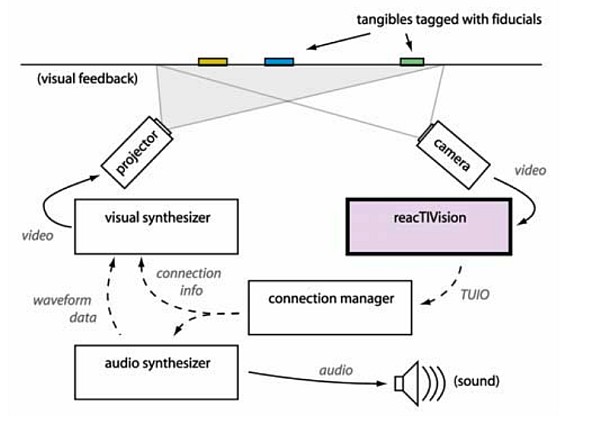Taking the two basic concepts of blocks and tables, four graduate students from the Univesitat Pompeu Fabra in Barcelona, Spain, added music to the mix and designed something called the reactable. The reactableis essentially a music synthesizer, and if you hear it played, it sounds similar to a lot of modern electronic dance music. The difference between the reactable and a typical synthesizer, however, is that participants manipulate sound with blocks on a round table. By rotating or moving the blocks on the table, a person (or several people) can tweak a variety of sounds, beats and notes, creating an electronic soundscape.
In addition to the ease with which you can maniupulate sound, there’s also a visual element: The table has a translucent blue surface that lights up with dynamic animations that highlight the musical changes. For musicians and spectators alike, the reactable is a musical instrument that’s not only fun to listen to, but fun to watch as well.
Reactable Basics
Although it’s bright and flashy on the outside, the reactable is, at its most basic, a music synthesizer, a musical instrument that electronically manipulates notes and tempos, bending and shaping the properties of sound waves. These manipulations create interesting noises and variations on musical notes that musicians can’t easily make with regular acoustic instruments like pianos or guitars. By turning a knob on a keyboard synthesizer while holding down a note, for instance, the user can make the pitch of a note bend and waver, making eerie electronic sounds that swell up and down.
When four students from the Univesitat Pompeu Fabra — Sergi Jordà, Martin Kaltenbrunner, Günter Geiger and Marcos Alonso — set out to design the reactable, they did so while keeping a few basic principles in mind. They wanted the instrument to be collaborative: Even though it’s possible for one person to play alone, the table is round and allows many people to gather around and interact with the instrument’s several blocks. The reactable should also be intuitive and easy to learn, yet challenging to listen to and play. If someone were to walk up to the table without a set of instructions or any guidance, that person should be able to pick up the basics fairly quickly. In other words, anyone, from inexperienced or novice players to seasoned DJs, has the ability to make the reactable sound and look cool, according to its makers.
In the team’s words, the reactable is a “novel multi-user electro-acoustic musical instrument with a tabletop tangible user interface” [source: Universitat Pompeu Fabra]. While it’s a bit of a mouthful, the phrase explains the instrument nicely. The reactable is, of course, a multi-user instrument — a certain number of people stand around the object and, using their hands, create sound by manipulating the blocks. It takes a certain amount of skill to learn, but with enough practice, it’s possible to play with ease. Although it’s somewhat of an umbrella term, any music that is “electro-acoustic” refers to music that’s been produced with the use of electricity. In the case of the reactable, all sound coming from the synthesizer is electronic, and therefore electro-acoustic. The tabletop refers, of course, to the device’s surface, and the fact that it’s a “tangible user interface” simply means players can manipulate objects by using their hands, twisting and moving the blocks like knobs on a traditional synthesizer.
For more Details: How the reactable Works

